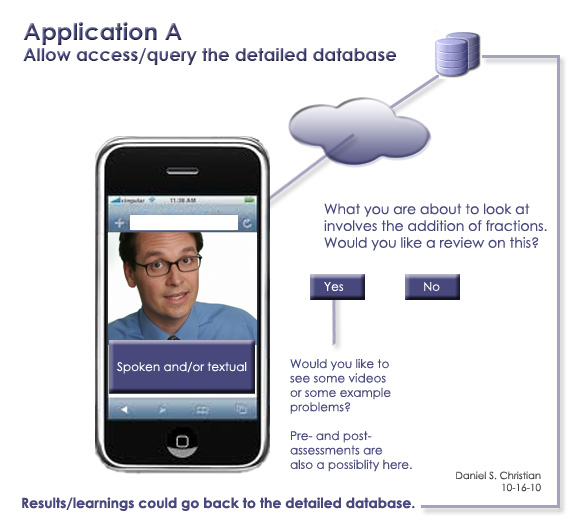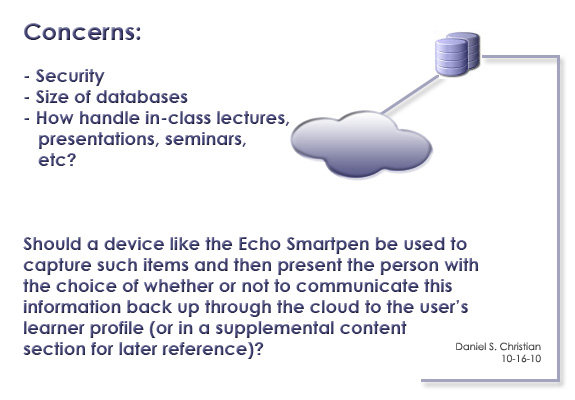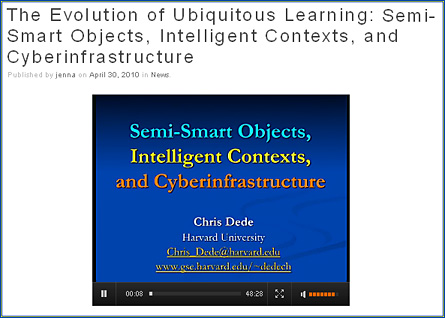|
Opportunities |
Challenges |
| Learner |
- Bridging informal and formal education
- Movement between schools to obtain courses needed for custom degrees
- Increase in shared knowledge among students and learners
- Networking and learning from each other
- Resumes will include informal and formal learning experiences acquired via the Internet
|
- Developing standards to gauge education and competency from multiple sources
- Providing an authoritative, reliable source for information (e.g. not just Wikipedia)
- Physical and psychological distance from other learners and instructors.
- Quality measures for informal and formal professional development attained on the Internet.
|
| K-12 Instruction |
- Reducing barriers to funding, certification, credit and accreditation
- Increase access to quality education for all students
- Open “course” concept to new blends of delivery and teaching
- Providing for more game-based learning experiences and techniques for a variety of learning styles
- Using new technology in the classroom
|
- Defining online and blended education
- Development of technical infrastructure, internet access and equipment
- Maintaining the custodial function of school
- Acquiring funding for bold Internet delivered experiences for the classroom
- Allowing use of new technology in the classroom
|
| Corporate Training |
- Just-in-time learning
- Greater access to information
- Peer coaching
- Cloud training
- Ability to reach those previously unreachable
|
- Intellectual property rights
- Resistance to using open content
- Peer review of resources
- Unknown impact of open universities
- Technical challenges related to size of offerings and rapidly changing technology
|
| Content |
- Tools allowing for easier collaboration and interaction
- Richer media experience (videos and simulations)
- Content repositories & Learning Object distribution and searchability
- Movement away from static textbooks as primary resource
|
- Growing tension between standard core content and differentiation of content
- Where will content for curriculum come from?
- What part will student-generated content play?
- More copyright issues
|
| Learning Environment |
- Customized learning spaces, i.e. personal learning environments (PLEs)
- Customization of content presentation and access
- eReaders and eBooks providing better and more interactive content (just in time)
- Changing paradigm of “bounded courses” to unbounded courses where learning is a continuous process that can occur anywhere and at any time
|
- Determining fit and purpose of new tools and pedagogical approaches
- Standards for smart phones/mobile apps
- Issues with accreditation, privacy and copyrights
- Universal access to technology, equipment, and the internet
|
| Faculty |
- More involvement and collaboration with online and distance learning initiatives
- More part-time faculty teaching for several institutions
- Faculty practices and entrepreneurs
- Changing role of faculty and PD instructors
|
- What will the primary role of faculty be?
- Faculty segmentation into master teachers, mentors, researchers, tutors, etc.
- Changing of promotion and tenure to accommodate different roles
- Changing pay structure
|
Administration
&
Management |
- Continued growth of open education with some program stabilization
- Improved learner focus
- Increased blending/blurring of traditional on-campus with online options
- More collaboration with other administrators to influence policy makers
|
- Managing and maintaining growth
- How to blend on and off campus learner programs
- Regulatory and accreditation issues
- Student accountability issues (plagiarism/doctoring)
- Improving faculty/ instructor readiness
|
| International Perspectives |
- Providing access to education even to remote, rural, and developing areas
- Promote intercultural mixing and diversity through education
- Improving educational access in segregated societies
- Sharing resources and co-producing content to reduce cost
- Serve new growing customer groups
- Informal learning, sharing own learning with others via internet (e.g. blogs, wiki)
|
- Technological infrastructure of societies
- Understanding of different people and places
- Eliminating the “we and they” thinking
- Illiterate audiences
- International/cultural conflicts
- Developing culturally aware curricula
- Differences in cost of education and fees
- Selecting suitable types of content delivery
- Refiguring content for different learner communities
|














